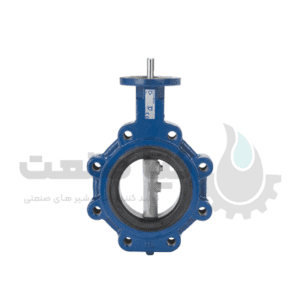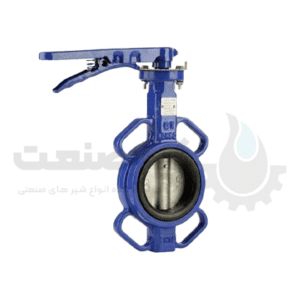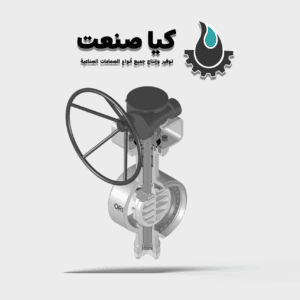
Your cart is empty!
Showing all 3 results
 برای سفارش و اطلاع از قیمت با ما تماس بگیرید
برای سفارش و اطلاع از قیمت با ما تماس بگیرید
 برای سفارش و اطلاع از قیمت با ما تماس بگیرید
برای سفارش و اطلاع از قیمت با ما تماس بگیرید
 برای سفارش و اطلاع از قیمت با ما تماس بگیرید
برای سفارش و اطلاع از قیمت با ما تماس بگیرید
Butterfly valve is a type of valve that is used to regulate fluid flow. It consists of a disc or plate mounted on a rod in the valve body.
When the valve is closed, the disc blocks the flow of fluid and when it is open, the disc allows fluid to pass through.
The disc is connected to a valve handle or actuator that controls the position of the disc and thus the fluid flow.
Butterfly valves are usually used in various industries such as oil and gas, water treatment and HVAC systems. They are known for their compact design, lightweight construction and ease of use.
Butterfly valves are valves that can be used to regulate, isolate, stop or start fluid flow.
These valves are mostly used as control valves in applications where the pressure drop required by the valves is relatively low.
Butterfly valves are rotary motion valves and are easy to operate due to the handle that rotates ninety degrees, and this handle rotation can fully open the disc.
Butterfly valves are mostly small in size, larger butterfly valves can be actuated by a handwheel, which is connected to a stem by gears.
Butterfly valves are lightweight, small, quick to shut off flow, and can also be used for throttling.
These butterfly valves can handle a large flow of liquids or gases at low pressure and can also handle slurries or liquids that have a large amount of suspended solids.
Concentric Butterfly Valve: This type of valve has a stem that passes directly through the center of a disc that seals against a seat located in the valve body. It is commonly used in low pressure applications and has a simple design that facilitates maintenance.
Dual Offset Butterfly Valve: This valve design has one disc offset from the center of the valve seat, as well as a second offset in the stem. This configuration reduces the contact area between the disc and the seat, resulting in less friction and wear. Double butterfly valves are suitable for high pressure and high temperature applications.
Triple offset butterfly valve: This type of valve has a disc with three spaces.
One from the centerline of the seat, one from the centerline of the stem and the other from the centerline of the tube.
The triple offset design provides a tight shutoff and minimizes wear.
These valves are usually used in industries such as oil and gas, petrochemical and power generation.
Unusual butterfly valve: The design of this valve has a disc that is separated from the centerline of the pipe and seat. It provides a strong bubble quencher and is suitable for applications requiring two-way sealing. Eccentric butterfly valves are commonly used in applications where the fluid contains solids or thick materials.
Compact design: Butterfly valves have a relatively simple and compact design that makes their installation and maintenance easy. They require less space compared to other types of valves.
Affordable: Butterfly valves are generally less expensive than other types of valves, such as gate or globe valves. This makes them a cost-effective option, especially for large-scale industrial applications.
Fast Operation: Butterfly valves can be operated quickly and easily, allowing for efficient flow control. Their quarter turn function (90° turn) allows quick opening and closing.
Low pressure drop: Butterfly valves have a low pressure drop, meaning they create minimal resistance to flow. This can help maintain an efficient flow rate and reduce energy consumption.
Applicability in all industries: Butterfly valves can be used in a wide range of applications in various industries, including chemical, wastewater treatment, pharmaceutical, HVAC and water distribution systems. They can handle different types of fluids including liquids, gases and slurries.
Butterfly valves are relatively easy to maintain due to their simple design and fewer components compared to other valves. They often have lower sealing levels that reduce the chance of leaks or failure.
Flow control:
Butterfly valves offer excellent flow control capabilities that allow precise regulation of fluid flow. They can be adjusted to achieve different flow rates and throttle requirements.
Ability to automate:
Butterfly valves can be easily automated using actuators, allowing for remote operation and control. This automation can improve efficiency and increase process automation.
Easy installation:
Butterfly valves are relatively easy to install due to their simple design and fewer components. They usually require fewer fittings and connections compared to other valves, which simplifies the installation process.
Flow control:
Butterfly valves offer excellent flow control capabilities that allow precise regulation of fluid flow. They can be adjusted to achieve different flow rates and throttle requirements.
Ability to automate:
Butterfly valves can be easily automated using actuators, allowing for remote operation and control. This automation can improve efficiency and increase process automation.
Easy installation:
Butterfly valves are relatively easy to install due to their simple design and fewer components. They usually require fewer fittings and connections compared to other valves, which simplifies the installation process.
Flow control is done with the help of a disk, and the disk has the same diameter as the adjacent pipe, which rotates on a vertical or horizontal axis.
If the disc is placed parallel to the piping path.
The valve opens fully and closes when the disc approaches the vertical position.
Butterfly valves consist of a disc that rotates in bearings.
In the open position, the disc is parallel to the pipe valve, allowing full flow through the valve.
And in the closed state, it rotates on a seat and perpendicular to the pipe wall.
Most impeller walls are used for low temperature and low pressure applications due to their soft seats.
برای غلبه بر این ایرادات، شیرهایی با Higher temperature seats or high-quality machined metal-to-metal seats are available.
Fluid passing through a butterfly valve creates a small pressure drop and the valve offers little resistance to flow when open.
The sealing action of these valves is achieved by rotating a disk with a diameter equal to the pipe from a position in line with the fluid flow to a position perpendicular to the flow.
If spring seats or piston rings are used on the disc.
These valves can be sealed with a relatively low opening torque on the valve stem.
This sealing action is done by the fluid pressure distribution that tends to close the valve.
This same hydraulic imbalance requires that a latching device or worm gear be installed to prevent manually operated valves from closing unintentionally.
Butterfly valves can be used in fresh water and salt water.
Grout and similar services
Water and steam service with high pressure and temperature
It can be used for isolation and blocking.
It can be used in process services as a regulator where precise control is not required.
Copied to clipboard